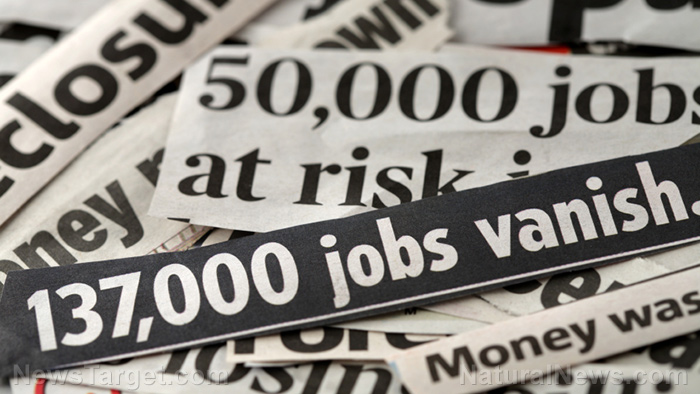REPORT: 29% of Americans earn above the poverty line but still LESS than what they need to comfortably get by
04/30/2024 / By Laura Harris

Nearly 40 million families, or 29 percent of the total American population, are earning above the poverty line but less than what they need to get by.
This is according to data from the nonprofit United Way, which described these 29 percent of Americans as falling in the category of ALICE, or Asset Limited, Income Constrained and Employed. Their classification in the ALICE category is attributed to higher costs and stagnant wage growth.
According to Brett House, an economics professor at Columbia Business School, households within the ALICE category earn above the federal poverty level but struggle to cover basic expenses. House added that many lower middle class families classify as ALICE households, meaning they can meet their immediate needs but lack the financial cushion to make significant savings, major investments or shell out for emergencies.
Stephanie Hoopes, the national director at United Way’s ALICE-focused division, United For ALICE, added that ALICE households represent essential workers such as childcare providers, home health aids and cashiers, who are on the front lines of service but struggle to make ends meet.
“The ALICE households, in particular, have borne the brunt of inflation,” said Greg McBride, chief financial analyst at financial services firm Bankrate. “Even though we’ve seen wage growth on the low- to moderate-income scale, that’s also where inflation has hit the hardest.”
ALICE workers were celebrated as essential heroes during the onset of the Wuhan coronavirus (COVID-19) pandemic 2020, but these households often do not qualify for public assistance. Instead, ALICE households, just like the households at or under the federal poverty level, are forced to make tough choices, such as deciding between quality childcare or paying the rent. (Related: Inflation comes roaring back as Bidenomics harms American households.)
High interest rates hurt the labor market
The burden of relentless inflation surges is far from evenly distributed in American society.
Since the onset of the pandemic, inflation has surged to its highest levels since the early 1980s. This, along with the stubborn persistence of inflation, has thrust many families perilously close to financial breaking points.
In response, the Federal Reserve launched a series of interest rate hikes, driving its benchmark rate to unprecedented highs not witnessed in over two decades. However, these measures failed to quell inflation. This, in turn, left households grappling with soaring consumer borrowing costs and mounting pressure on their finances.
The consequences of this inflationary spiral are starkly evident in the labor market.
For many lower-income households, avenues for mitigating the impact of inflation are limited. Lower-income households became dependent on credit cards due to constrained spending flexibility and dwindling savings to bridge the financial gap. In turn, credit card debt has reached an all-time high in 2023, while the personal savings rate has plummeted.
All this, despite real average hourly earnings rising at only 0.6 percent over the past years, while credit card delinquency rates soar to 3.1 percent at the close of 2023, marking the highest level in 12 years.
These families, grappling with high inflation and stagnant wages, find themselves caught in a precarious balance, where the persistence of high interest rates constrains their ability to secure higher incomes while simultaneously impeding their capacity to weather financial storms.
“Keeping rates high is hurting the labor market and ALICE’s ability to have higher wages,” said Hoopes.
Learn more about the true state of the American economy at EconomicRiot.com.
Watch economist Steve Moore explain why Americans will still feel the dire effects of inflation in the coming months.
This video is from the News Clips channel on Brighteon.com.
More related stories:
Biden blames inflation on CLIMATE CHANGE, citing bogus study.
Biden declares inflation “over,” orders companies to lower prices.
Food shortages and inflation continue as “Bidenomics” SPECTACULARLY FAILS.
Inflation, cost-of-living crisis crushing Generations Y and Z.
Sources include:
Submit a correction >>
Tagged Under:
Asset Limited Income Constrained and Employed, Bubble, Collapse, cost of living, debt bomb, debt collapse, earnings, economic collapse, economic riot, economics, economy, Federal Reserve, finance riot, Inflation, market crash, money supply, pay, pensions, poverty, risk, United Way, wage growth
This article may contain statements that reflect the opinion of the author
Get independent news alerts on natural cures, food lab tests, cannabis medicine, science, robotics, drones, privacy and more from NewsTarget.com
Get independent news alerts on natural cures, food lab tests, cannabis medicine, science, robotics, drones, privacy and more from NewsTarget.com
RECENT NEWS & ARTICLES
COPYRIGHT © 2017 DEBT COLLAPSE NEWS



















